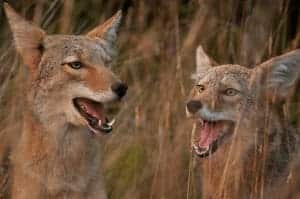Coyote America (2016) Champions an Often Maligned Canine
They live all across continental North America, from Canada to Panama. They’ve had a long history of humans revering them as trickster gods, vilifying them as threats to livestock and pets, depicting them as hapless cartoon characters chasing after roadrunners, or defending them as necessary for their ecosystems. They’ve been hunted aggressively for centuries, and yet they survive and thrive.
They’re coyotes, and they’re the focus of writer and historian Dan Flores‘s wonderful book Coyote America: A Natural and Supernatural History (2016). Flores delves into the biology, ecology, and history of these natural predators to highlight the huge impact they’ve made on North America’s environmental and cultural landscapes.
Coyotes Have a Long Natural History and a Complex Relationship with Humans
https://gty.im/159293557
Coyote America traces the natural history of the animal from its earliest appearance around five million years ago to its modern ubiquity across mainland North America. Flores describes how, due to competition with gray wolves, coyotes evolved smaller bodies, more flexible social structures, and more diverse diets than their genetic relatives, which allowed them to form their own ecological niche. He explains how they help control populations of smaller animals to prevent them from overgrazing land and starving to death.
The book also details the diverse and sharply divided relationships humans in North America have had with coyotes. Many Native American tribes tell entertaining and enlightening stories of the admirable yet realistically flawed trickster demigod Coyote, while many western settlers, ranchers, and hunters have aggressively hunted the animals, viewing them as threats to livestock and game animals. The United States government has culled millions of the species’ members over the past two centuries and still hasn’t provided endangered species protections for them. Wildlife activist groups like the Sierra Club, Defenders of Wildlife, the Humane Society, and Project Coyote continue to fight against the killing of coyotes and for stronger protections for the species.
Coyotes Continue to Expand Their Range Despite Hostilities from Humans
Flores does an excellent job explaining how coyotes have managed to expand from their historical ranges in the American Southwest to become present all across North America despite being aggressively hunted, poisoned, and vilified for centuries. Their broad diets make them harder to poison than wolves. Their ability to mate multiple times a year allows them to survive a 70% population loss one year and be back to full size the next. They also adapt to human environments much better than wolves do. Some even like riding the subway!
Flores also defends coyotes against long-held beliefs that they are major threats to humans, pets, and livestock. Contrary to common arguments farmers and ranchers make, Flores shows that coyotes and wolves cause a very small percentage of livestock deaths compared to far more common causes like diseases and bad weather. Although Americans in urban environments often believe that coyotes are overly aggressive towards pets and humans, Flores explains that they rarely kill domestic cats or dogs and that confirmed incidents of them killing humans number in the single digits.
They’re a Quintessential American Icon
Flores makes a strong case that the coyote is an ideal reflection of American values and the American people. He offers several reasons why he believes humans are fascinated by animals, whether or not they actually like them. Humans and coyotes are both around the same age as distinct species and have, in a way, evolved alongside each other. Humans have often used the canines as symbols of survival in tough situations, of countercultural resistance, or of various human strengths or shortcomings. Since many coyotes live in or near human environments, many people in North America have probably encountered one at least once in their lives and have a story of their own to share about those encounters.
Final Thoughts
In Coyote America, Dan Flores provides an excellent analysis and defense of one of North America’s most prominent natural predators. He also argues passionately for the conservation and respect the coyote deserves. His book should be required reading for every American.
Even if you are not from North America and may never encounter a coyote in person, the book can help you envision and examine your relationships with natural predators wherever you live. Do you believe they’re threats that should be controlled, limited, or eliminated, or do you believe they play important ecological roles and should be protected and allowed to live freely?
If You Liked This Article, Check Out:
- Tigers: 1 Tiger’s Journey of Survival, Motherhood, and Redemption
- Garfield Movie (2024) Looks to Leave Audiences in Stitches
- Own the Epic Adventure! RV Living 2024
For More Great Content
Total Apex is an all-encompassing content producer. We provide heavily detailed articles every day on entertainment, gaming, sports, and so much more! For more exemplary gaming and entertainment content, read our daily content on these sites: Total Apex Gaming and Total Apex Entertainment.






